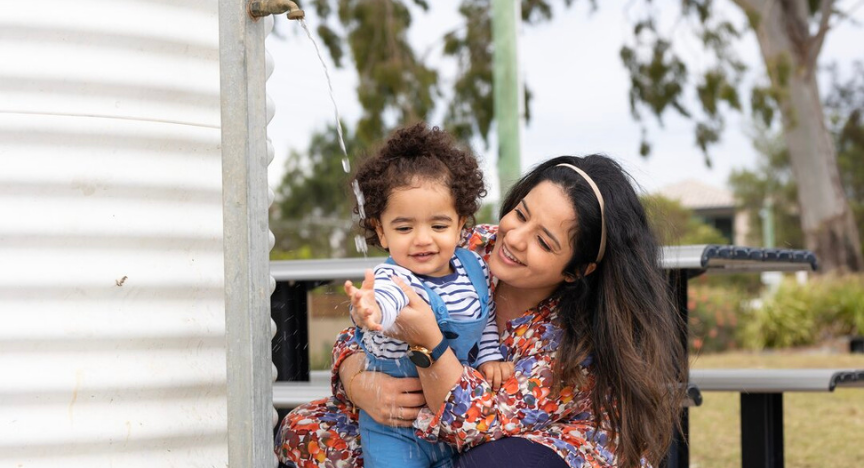Endometriosis can be a painful and debilitating condition. Around 1 in 10 people who currently or used to have a uterus experience endometriosis.
For different reasons, many will suffer for years before they reach a diagnosis and can access treatment.
Queensland woman Claire shared her endometriosis story to encourage others to understand endometriosis and seek help if they have symptoms.

The first signs of endometriosis
At 12 years old, Claire had just started having her monthly period. What she didn’t know was that the immense pain she was experiencing during menstruation wasn’t normal.
‘One of my earliest memories of knowing my period pain wasn’t quite normal or didn’t match my peers’ experience was when my Year 8 maths teacher had to rush me to hospital because I had fainted, writhing in pain on the floor, and vomiting as a result,’ said Claire. ‘A distraction from algebra, yes, but not one I personally wanted!’
Claire’s maths teacher drove her straight to the hospital, where emergency doctors tried to rule out serious conditions like an ectopic pregnancy. Claire remembers feeling alarmed and embarrassed as the doctor questioned her reproductive health.
‘I hadn’t even had my first kiss at that point and was mortified. I remember my parents turning up to the hospital and my stress levels went through the roof. This made my pain even worse. Fortunately, the “pregnancy” I knew I didn’t have was ruled out, and I was referred to my GP for follow up.’
What is endometriosis?
Endometriosis is a condition in which the tissue that normally lines the uterus (the endometrium) grows in other parts of the body. It can affect the reproductive organs and other pelvic organs and tissues, including the bowel and bladder.
Endometriosis affects girls, women and people assigned female at birth. It can begin in adolescence and may continue after menopause or if someone has had their uterus removed (a hysterectomy). Endometriosis is a progressive condition, which means symptoms can worsen over time.
Endometriosis causes abnormal bleeding outside of the uterus and can lead to the formation of scar tissue and adhesions. These factors can cause inflammation, irritation, and severe pain, and can also lead to fertility issues.
Endometriosis symptoms depend on where the endometrial tissue is located. Symptoms of endometriosis can include:
- painful periods
- pain on or around ovulation
- pain during or after sex
- pain in the pelvic region, lower back or legs
- heavy or irregular bleeding
- pain with bowel movements or urination
- having trouble holding on when you have a full bladder or frequently needing to go to the toilet
- nausea
- fatigue.
Some people with endometriosis experience severe symptoms, while others may not have any symptoms at all. Pain levels aren’t a clear indicator of how extensive the endometriosis is; you could have mild endometriosis and severe pain, or extensive endometriosis and little or no pain.
‘In the wilderness’ of pain for too long
After her hospital visit, Claire didn’t follow up with her GP. Despite having a supportive network of friends and family, menstruation wasn’t a topic that was openly discussed.
‘The whole episode fell into the “Let’s never speak of that again” category,’ Claire said. ‘My period pain and its impact on my life wasn’t something I felt I could chat about, and because I appeared to be managing it, no one raised it with me either.
I was “in the wilderness” like this for too long. I began to question whether I was just weak or had a low pain tolerance.’
Claire was taking over-the-counter medication for the pain, but her symptoms were progressively becoming more severe and difficult to manage.
‘I began to experience heavy flooding. This meant ‘black pants’ only during that time of the month and sometimes, embarrassingly, having to check the chair I’d been sitting on to make sure there’d been no leaks. I missed a lot of school and the ever-important after-school activities teens crave.’

Endometriosis symptoms reach a tipping point
Despite the impact her symptoms were having on her daily life, Claire persevered for years before a string of events led her to important answers.
‘It was only when I entered the workforce as a young graduate, having travelled interstate for the job of a lifetime, that I realised how much this problem had the potential to impact on my attendance at work and how alone I felt. Something had to be done.’
Claire’s new manager had recognised something was wrong, and the support he offered was a turning point in Claire’s experience.
‘He approached me in the most sensitive way—graciously extending the offer to meet his wife who’d suffered with the same issue for years, to discuss her action plan … and, importantly, provided an opportunity for me to finally speak freely about it with someone who knew my “secret” only too well from her own experience.’
This connection gave Claire the confidence to make her first appointment with a gynaecologist.
‘The gynaecologist was completely understanding and made me feel my concerns were legitimate. He made me feel empowered and in control.’
After a range of medical tests, Claire underwent a diagnostic laparoscopy, a surgical procedure that uses a small camera to investigate the affected area. Claire finally learned that endometriosis was cause of the crippling pain that had been a part of her life for so many years.
‘My specialist showed me a normal pelvis, then mine, and I was shocked. It resembled cobwebs encasing my ovaries, bowel and fallopian tube. He said each month, the endometrial tissue that was growing outside of my uterus within my pelvis had nowhere to escape and the end result was the scar tissue we saw, known as “adhesions”.’

Help for endometriosis is available
In the years since she was diagnosed with endometriosis, Claire has undergone a range of procedures that have greatly improved her quality of life, including several laparoscopies and a bowel resection.
For Claire, the most important step in her journey was connecting with a specialist who could help her with this common yet very personal problem. She hopes that sharing her story will show others that help is available and encourage them to seek medical advice.
‘I want to give hope to those who might have little hope left and tell them that my life has greatly improved since these interventions.
Please, if you’ve got a daughter who’s missing school, a friend who might be having a hard time “each month”, speak up. Tell them about endometriosis and how early diagnosis is best. Encourage them and let them know there’s help out there.’
Think you might have endometriosis?
Endometriosis can affect people in different ways. If you are experiencing painful periods or other symptoms of endometriosis, it’s important to seek medical advice from your doctor or gynaecologist. A range of treatments are available and are targeted to each individual case.
More information
Endometriosis resources can be found at: